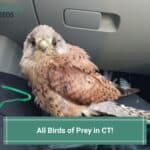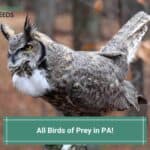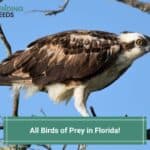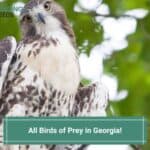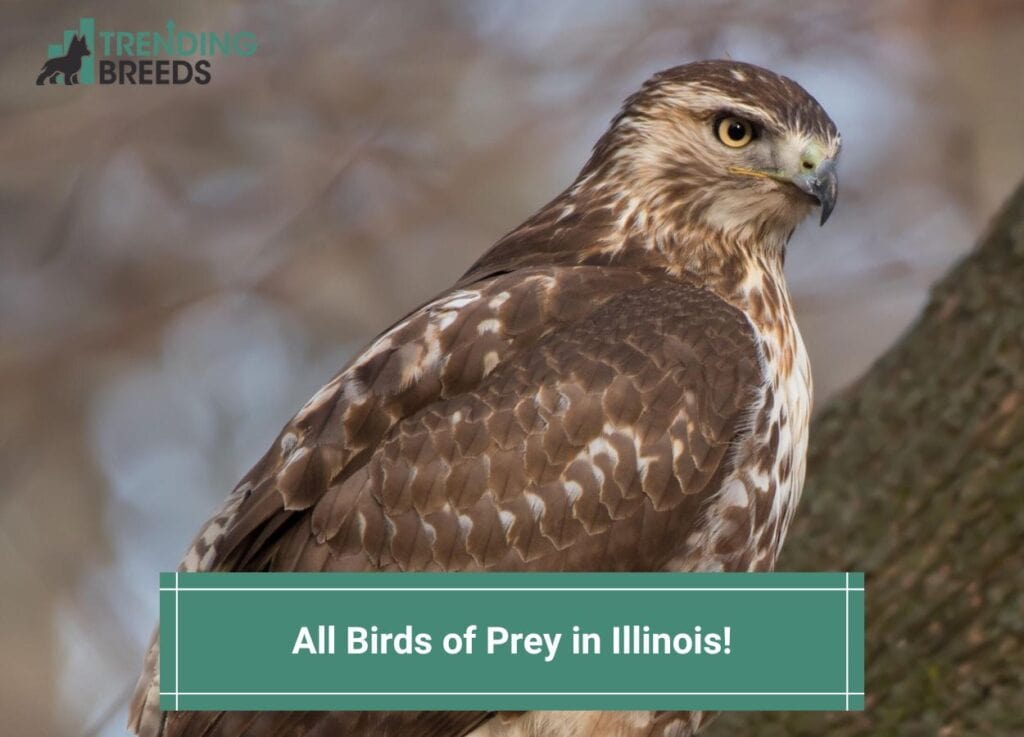
Illinois is a haven for you if you like birdwatching and taking fascinating pictures of raptors in action. Whether they’re Eagles, Vultures, Hawks, Owls, or Falcons, the birds of prey in Illinois play a significant role as top predators in the ecosystem.
The state is home to more than 400 species of birds, among which birds of prey make up a large proportion of its varied habitat and diverse avifauna.
They vary in appearance, habitat, and hunting tactics, so spotting one in the wilderness would be a truly memorable experience.
In today’s article, we’ll discuss the mighty predators that rule the skies of Illinois.
Before you scroll further down this guide, check out these other bird-related articles: All Birds of Prey in Maine and All Birds of Prey in Montana.
Table of Contents
1. Burrowing Owl
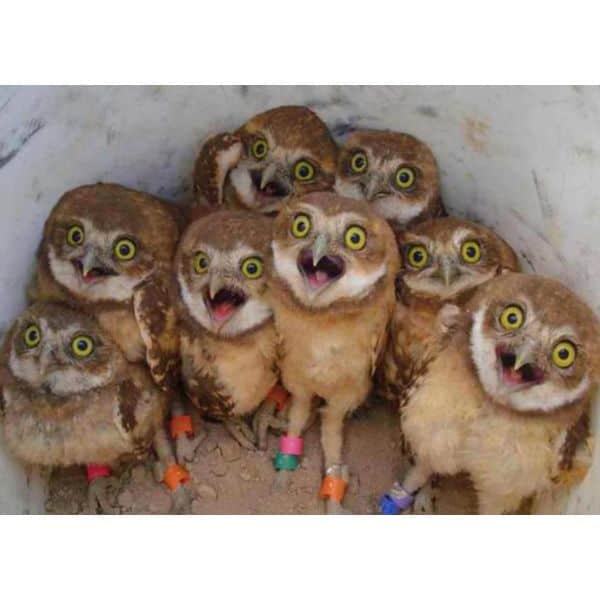
Burrowing Owl Characteristics:
- Scientific Name: Athene cunicularia
- Size: 9-11 inches
- Weight: 0.33 lbs.
- Wingspan: 20-24 inches
- Lifespan: 6-8 years
- Conservational Status: Least Concern
We begin our list with the Burrowing Owl. This bird of prey is extremely rare in Illinois and is considered an accidental species.
However, there have been occasional sightings. Burrowing Owls are relatively small but have long legs. They mainly live in prairie dog burrows, which is how they got their name.
Burrowing Owls typically have brown feathers with many white spots. Younger Owls have slightly lighter plumage.
They have yellow eyes and bills, no ear tufts, and a white patch on their chins, which can be seen when irritated or bobbing their heads.
Burrowing Owls are commonly spotted in deserts, open grasslands, agricultural areas, and prairies.
Unlike most Owl species, they hunt during the day and night and look for prey on the ground, in shallow water, or perched on fence posts.
Their diet includes small birds, rabbits, mice, gophers, bats, and lizards.
2. Northern Harrier
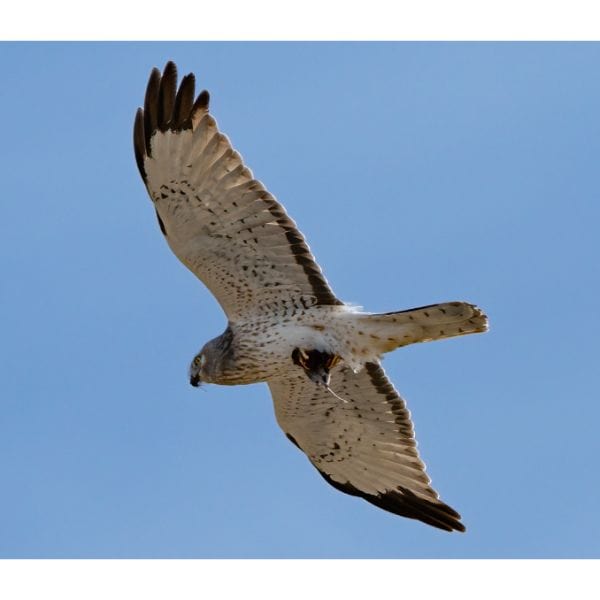
Northern Harrier Characteristics:
- Scientific Name: Circus hudsonius
- Size: 18.1-19.7 inches
- Weight: 0.66-1.66 lbs.
- Wingspan: 40.2-46.5 inches
- Lifespan: 16 years and 5 months (longest reported)
- Conservational Status: Least Concern
Northern Harriers migrate to Illinois to spend the winter. Their size ranges between a crow and a goose. These raptors have slender bodies, long tails, and broad wings.
They are often spotted gliding low over marshes and grassland.
This bird of prey typically flies, keeping its wingtips higher than its body, making a V-shape.
Moreover, males and females differ slightly in appearance; females have brown plumage, while males have gray upper sides and white underbellies with a white rump patch.
Northern Harriers inhabit open prairies, grasslands, and marshes.
They have a distinct foraging tactic where they slowly fly close to the ground and pounce on unsuspecting prey caught in the open.
Regarding diet, these predators generally eat small birds and mammals.
3. American Kestrel
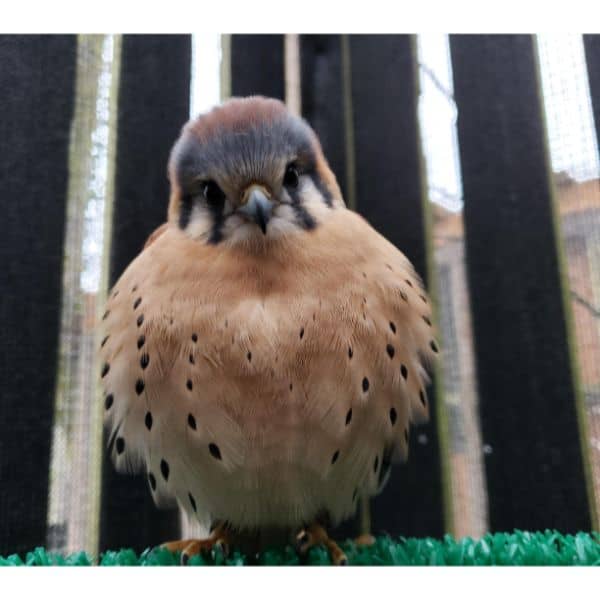
American Kestrel Characteristics:
- Scientific Name: Falco Sparverius
- Size: 9-12 inches
- Weight: 0.24 lbs.
- Wingspan: 20-25 inches
- Lifespan: less than 5 years
- Conservational Status: Least Concern
American Kestrels are Illinois’s smallest, most colorful, and most commonly spotted falcons. They are present in the state all year round.
Although similar in size and habits, the male and female Kestrels vary in coloring and markings.
The male American Kestrel flaunts rufous orange upperparts and tail.
It has bluish-gray wings with dark, pointed tips, a reddish-orange cap on the crown, a dark mustache, and a dark bar behind its eye.
The female American Kestrel has paler coloration and more pronounced barring.
American Kestrels typically live in open areas without dense foliage, such as grasslands, pastures, meadows, plains, agricultural fields, and occasionally urban areas.
They often perch on trees and low shrubs or hover close to the ground, scouring the area for insects, mice, frogs, lizards, voles, and small birds.
Once spotted, they can even catch prey while in flight.
4. Swallow-Tailed Kite
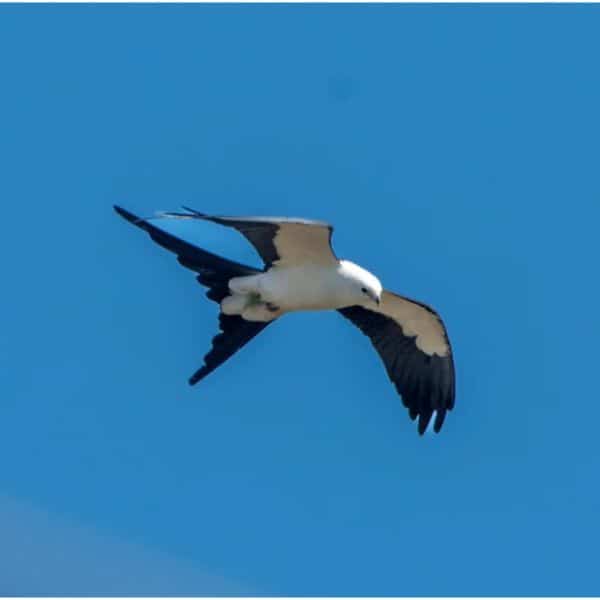
Swallow-tailed Kite Characteristics:
- Scientific Name: Elanoides forficatus
- Size: 19-25 inches
- Weight: 0.98 lbs.
- Wingspan: 45-50 inches
- Lifespan: 6 years
- Conservational Status: Not listed as endangered or threatened by the federal US government; status in other states differs.
Swallow-tailed Kites are termed rare or accidental birds of prey in Illinois.
However, they can usually be spotted in summer since they migrate to South America for winter.
These raptors are large, slender birds mostly seen hovering in the skies, flaunting their distinct forked ‘swallow-like’ tails.
Swallow-tailed Kites are identifiable by their pale heads and underbellies. Their tails, flight feathers, feet, and beaks are black.
Moreover, they have white and black underwings, which can be seen in flight. These predators commonly inhabit marshes, swamps, and lowland, humid forests.
Swallow-tailed Kites are well-known for their agile aerial acrobatics, during which they swerve, turn, roll, dive, and flick their forked tail to catch prey.
Their primary food includes cicadas, dragonflies, bees, wasps, crickets, and beetles, which they consume during flight.
Moreover, they also catch small snakes, lizards, frogs, and small birds when flying through treetops.
5. Boreal Owl
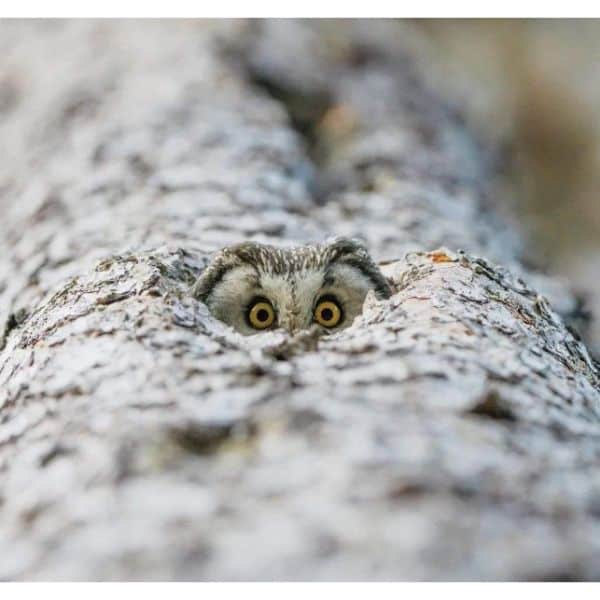
Boreal Owl Characteristics:
- Scientific Name: Aegolius funereus
- Size: 9-10 inches
- Weight: 0.23 lbs.
- Wingspan: 20-26 inches
- Lifespan: 16 years
- Conservational Status: Least Concern
Although Boreal Owls are rare in Illinois, they have been acknowledged by the Illinois Ornithological Records Committee under their review list.
These are rather small owls with comparatively large, square-shaped heads. Adults are typically brown with white spots on their backs and heads.
Boreal Owls have whitish or grayish faces with a black or brown border. Like most owl species, their eyes are bright yellow.
Their beaks are light yellow, and their white bellies feature vertical brown streaks.
As their name suggests, these raptors inhabit northern or boreal coniferous forests and normally live on high-elevation mountains with fir, aspen, poplar, birch, or spruce trees.
Boreal Owls are nocturnal; however, they can hunt in daylight in zones where nights are short.
Interestingly, one ear opening of these owls is considerably higher than the other, which helps them estimate the height and distance of sound to precisely locate small birds, insects, voles, shrews, mice, frogs, bats, and squirrels.
6. Swainson’s Hawk
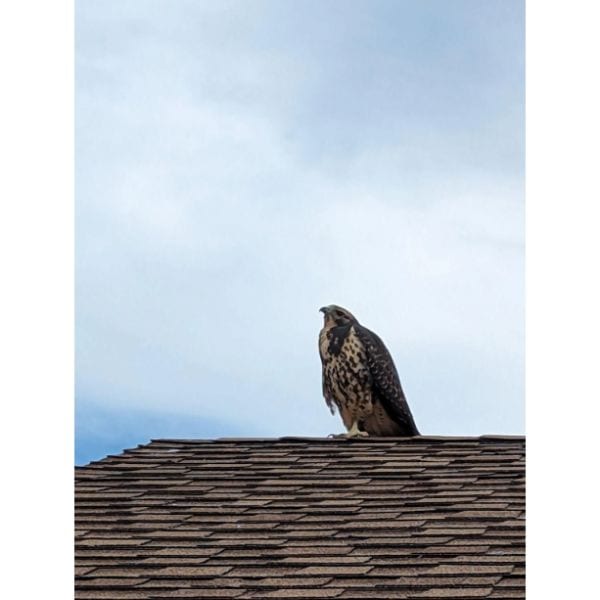
Swainson’s Hawk Characteristics:
- Scientific Name: Buteo swainsoni
- Size: 18.9-22.1 inches
- Weight: 1.52-3.01 lbs
- Wingspan: 48 inches
- Lifespan: 7-8 years
- Conservational Status: State-Threatened under the California Endangered Species Act
Since this is their breeding range, Swainson’s Hawks are most often spotted near the Mississippi River in the northwestern corner of Illinois.
April and September are when they are commonly seen flying in or out of their North American breeding grounds.
Amazingly, Swainson’s Hawks have one of the lengthiest migrations among North American raptors.
Swainson’s Hawks have relatively large, slim bodies, long, broad wings, and short tails. Nevertheless, they are less heavy than most hawks.
When in flight, they lift their wings to form a shallow ‘V.’ These predators have light underbellies, gray or brown upperparts, and reddish-brown chests.
Swainson’s Hawk inhabits open areas like grasslands, savannas, cultivated lands, and steppes.
In urban environments, they routinely perch on fence posts, telephone poles, and tree branches, scouring the area for food.
Swainson’s Hawk is sometimes called the Grasshopper Hawk or Locust Hawk because their diet exclusively consists of insects.
7. Merlin
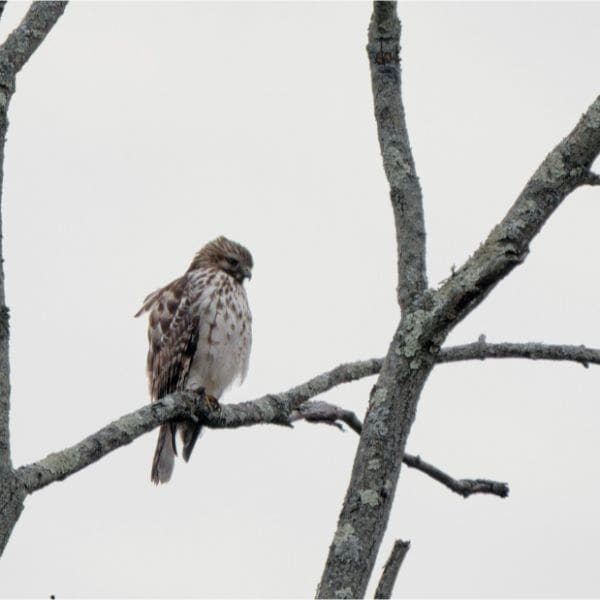
Merlin Characteristics:
- Scientific Name: Falco columbarius
- Size: 11-13 inches
- Weight: 0.46 lbs.
- Wingspan: 23-26 inches
- Lifespan: 6-8 years
- Conservational Status: Least Concern
Merlins are predominantly seen in Illinois in winter; however, their numbers increase from September to mid-November during migration.
These small yet fierce falcons are larger than the American Kestrel and have stockier bodies with sharp, pointy wings and a medium-length tail.
Merlins have pale undersides and dark backs; however, this can range from brown.
Their bills are small and hooked, with yellow skin on the bottom and around their dark eyes.
Female Merlins have lighter plumage than males, with brown-gray to dark brown backs, a whitish front, and brown spots on their underside.
Merlins are rather insatiable falcons who are always looking for their next meal.
They inhabit shrublands, boreal forests, prairies, grasslands, cemeteries, and coastal areas adjacent to rivers.
Merlins are also spotted in urban areas perched on treetops and telephone poles.
They usually hunt in pairs, chasing and exhausting their prey in flight, and prefer to eat small birds, insects, and reptiles.
8. Gyrfalcon
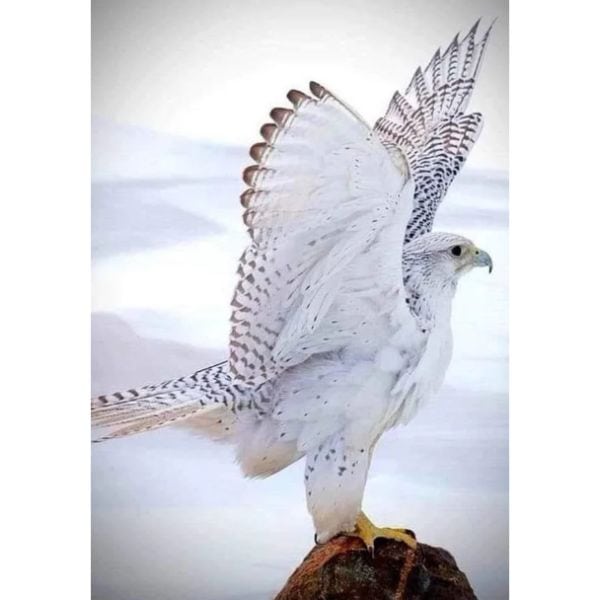
Gyrfalcon Characteristics:
- Scientific Name: Falco rusticolus
- Size: 20-25 inches
- Weight: 2.60 lbs.
- Wingspan: 48-64 inches
- Lifespan: 20 years
- Conservational Status: Least Concern
Gyrfalcons are among the extremely rare birds of prey in Illinois. However, a few individuals have been occasionally seen during winter.
These raptors are the largest among falcons and come in three morphs: dark, white, and silver/gray. The latter is most common in North America.
The silver/gray morphs have intense gray and white bands on their upper parts; however, some are predominantly gray with light banding.
Their underbodies have evenly distributed spots. The white morphs have brown/black bars on their upper bodies, dark wingtips, and a white tail. Some individuals also have barred tails and spotted breasts.
Gyrfalcons generally inhabit cliffs near rivers or shorelines with vast open hunting spaces.
During winter migration, they occupy areas with large reserves of prey, such as coasts, grasslands, river valleys, and farmlands.
Gyrfalcons primarily eat waterfowl and ptarmigans but also prefer songbirds, hares, and ground squirrels.
They hunt either by cruising low near the ground to scare prey or while flying high and striking down prey mid-air.
9. Mississippi Kite
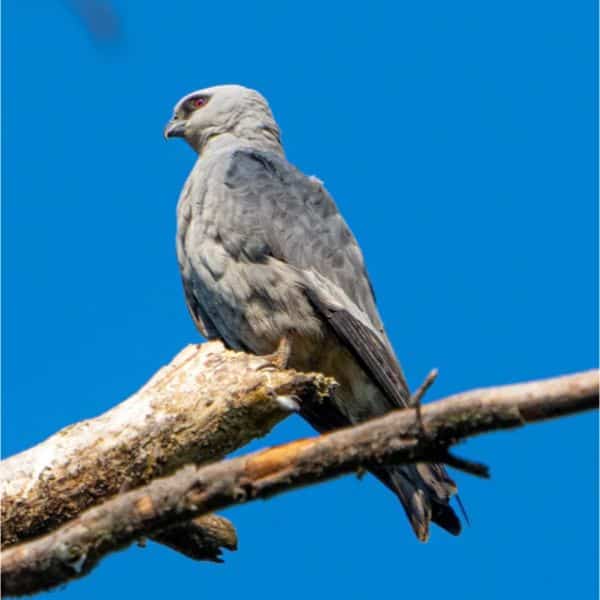
Mississippi Kite Characteristics:
- Scientific Name: Ictinia mississippiensis
- Size: 13-17 inches
- Weight: 0.79 lbs.
- Wingspan: 34-37 inches
- Lifespan: 11 years
- Conservational Status: Least Concern
Mississippi Kites are spotted in the south of Illinois between April and September.
These small and slender raptors have red eyes, dark eye patches, red legs and feet, light gray heads and underparts, and small, hooked bills.
Their upper parts and primary wings are dark gray, whereas their secondary wings are white.
Male and female Mississippi Kites are similar in appearance, except that females are slightly darker than males.
These birds of prey inhabit various areas, such as small woodland forests, prairies, dense hardwood forests, shelterbelts, golf courses, city parks, and other urban environments.
They love to float in the air and perch on tall trees and buildings.
Mostly, Mississippi Kites catch their prey mid-air and eat it during flight. This includes medium- and large-sized insects such as grasshoppers, cicadas, beetles, and dragonflies.
While hunting from treetops, they snag small birds, snakes, turtles, frogs, lizards, and fish. Occasionally, they hang around horses and deer and snatch any insects they flush out.
10. Black Vulture
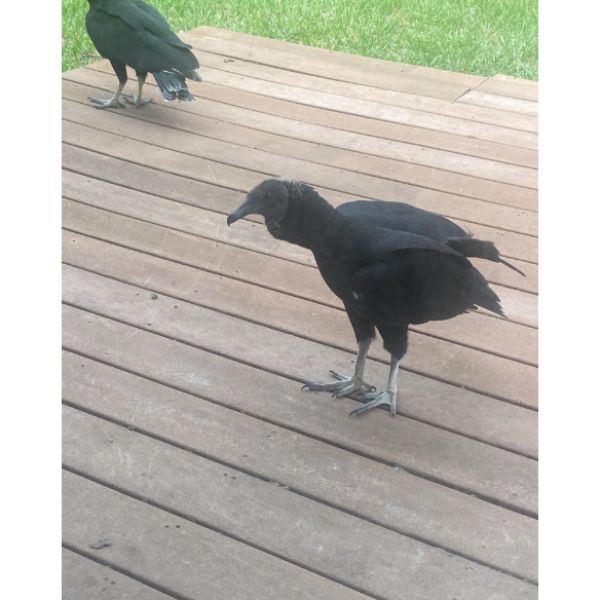
Black Vulture Characteristics:
- Scientific Name: Coragyps atratus
- Size: 23-27 inches
- Weight: 4.80 lbs.
- Wingspan: 54-60 inches
- Lifespan: 10 years
- Conservational Status: Least Concern
Black Vultures are usually spotted in the south of Illinois all year round.
It is easy to distinguish between a Turkey Vulture and a Black Vulture due to the color difference of their wings.
However, both are fierce raptors and fly with slightly raised wings resembling the letter ‘V.’
As their name suggests, these vultures are predominantly black. Their heads are gray and featherless, and their necks are wrinkled.
The undersides of their wings feature silvery patches, which give the impression of fingers when seen from below.
They have brown eyes and grayish-white legs. Black vultures commonly inhabit forested landscapes close to water bodies, such as grasslands, pastures, swamps, and shrublands.
Black Vultures will eat almost anything and are often spotted in urban areas going through garbage cans and dumps.
However, like all vultures, they mainly eat dead animals, including poultry, coyotes, raccoons, floating fish, and snakes.
Occasionally, they kill injured animals or hunt calves, tortoises, and lambs.
11. Snowy Owl
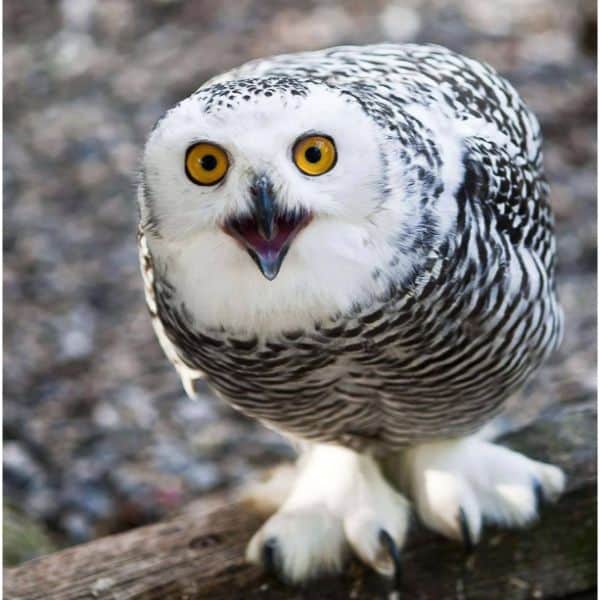
Snowy Owl Characteristics:
- Scientific Name: Bubo scandiacus
- Size: 20.5-27.9 inches
- Weight: 3.52-6.51 lbs
- Wingspan: 49.6-57.1 inches
- Lifespan: 10 years
- Conservational Status: Vulnerable
The Snowy Owl is the largest owl species in North America. These predators are considered rare winter visitors in Illinois and are spotted between mid-October and May.
Named after their magnificent white plumage, male Snowy Owls can be all white or feature some brown spots, whereas females have brown or black dots on their wings, backs, and flanks.
Female Snowy Owls also have thicker and more barred tails than males.
Both have bright yellow eyes and are among the few raptors whose legs and feet are covered with feathers to protect them from harsh, cold climates.
Interestingly, Snowy Owls become whiter with age.
When looking for prey, these predators prefer open areas and are often seen perched on fence posts and hay bales as vantage points.
Snowy Owls inhabit grassy meadows and marshes. However, they migrate south for the winter because of minimal prey.
Unlike most owls, these species are diurnal and hunt day and night. Their preferred diet is small mammals, particularly lemmings.
They also catch birds in flight, and in winter, they switch to more abundant prey such as rodents, squirrels, rabbits, ducks, and geese.
12. Osprey
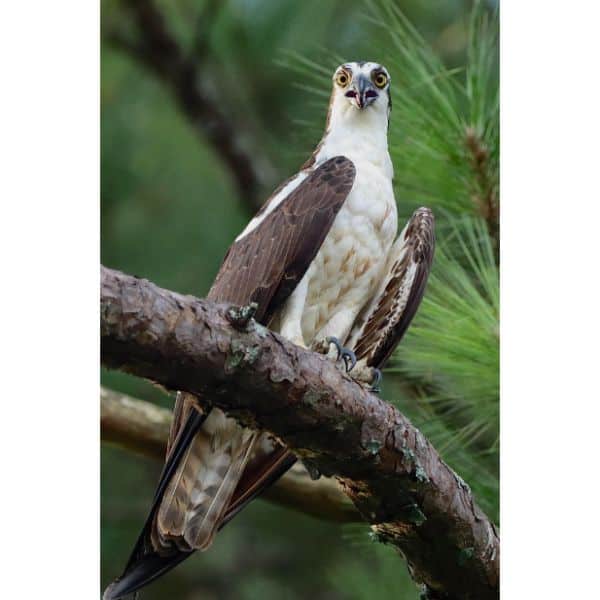
Osprey Characteristics:
- Scientific Name: Pandion haliaetus
- Size: 20-25.5 inches
- Weight: 3.0-4.4 lbs.
- Wingspan: 59-71 inches
- Lifespan: 7-10 years
- Conservational Status: Least Concern
Often mistaken for hawks, Ospreys are a distinctive species belonging to their own family (Pandionidae). These birds of prey flaunt brown upper sides and white undersides.
They are characteristically whiter than most raptors and seen in flight; their underwings are predominantly white with significant dark patches.
These birds have white heads and distinct wide brown stripes running through both eyes.
Regarding their diet, they are similar to Bald Eagles and feed mainly on fish. These birds of prey are opportunistic eaters and hunt whatever fish is available.
Ospreys have powerful, curved talons that interconnect when fully closed to catch their prey easily. This unique design helps them hold on to heavy, slippery fish.
Ospreys prefer habitats near water bodies such as lakes and rivers to ensure access to abundant prey.
They are often seen quarreling for fish with the Bald Eagle and sometimes steal its hunt!
13. Bald Eagle
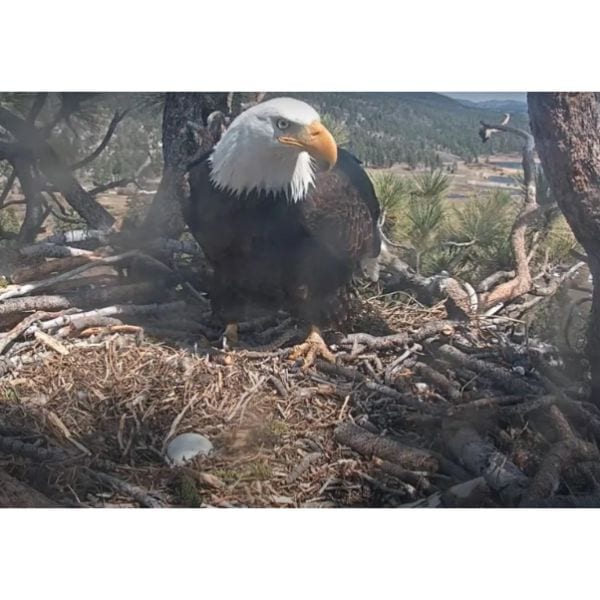
Bald Eagle Characteristics:
- Scientific Name: Haliaeetus leucocephalus
- Size: 27.9-37.8 inches
- Weight: 6.61-13.9 lbs.
- Wingspan: 80.3 inches
- Lifespan: 20-30 years
- Conservational Status: Least Concern
Speaking of the Bald Eagle, it’s the final raptor on our list of birds of prey in Illinois.
Possibly the most well-known and easily recognizable predatory bird in the United States, the Bald Eagle flaunts bright yellow beaks and a patch of white hair on their heads.
Unlike their name, these raptors have no bald spots; their name comes from the Old English word ‘piebald,’ which means ‘white patch,’ which refers to their white caps.
Bald Eagles inhabit forests close to large water bodies such as coasts, marshes, rivers, and lakes.
This provides them maximum access to fish, which, like the Osprey, is their primary food. Although these predators are fierce hunters, they often steal the hunt of other animals.
All the 13 Birds of Prey in Illinois
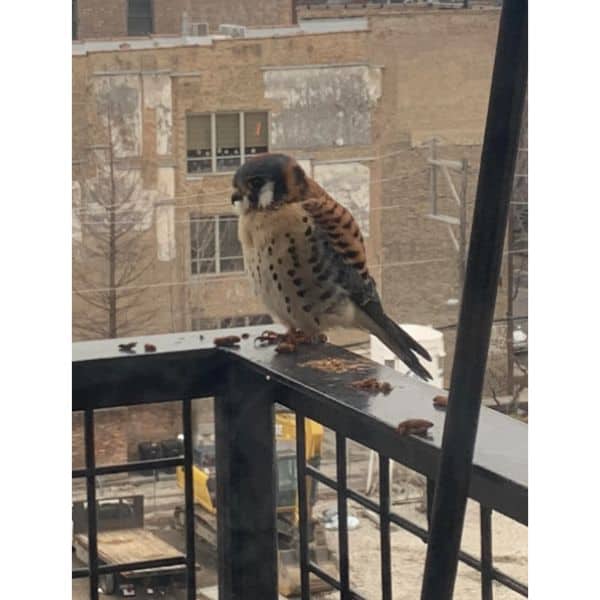
Since Illinois lies at the intersection of five major ecosystems, it features a diverse range of habitats.
This is why so many birds of prey permanently inhabit or visit the state.
These raptors can be spotted on mountains, near water bodies, and even around garbage cans and bird feeders.
We hope our guide helped you learn more about the birds of prey in Illinois.
Next time you go birdwatching, take your binoculars and camera and see how many you can spot!
If you find this guide, “All Birds of Prey in Illinois,” informative and helpful, you can check out these other bird-related articles from our team:
You can learn more about birds by watching “HOW TO TRAIN A HAWK | How to Train a Bird of Prey” down below:

